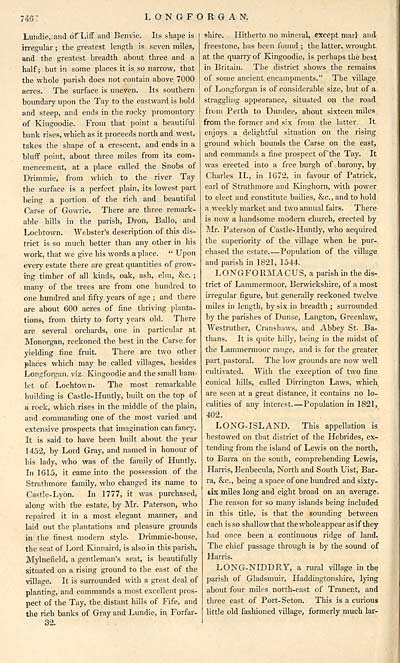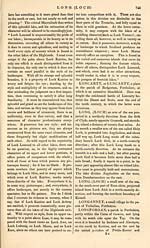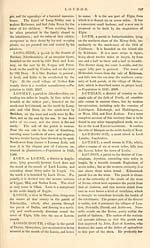Gazetteer of Scotland > Volume 2
(262) Page 746
Download files
Complete book:
Individual page:
Thumbnail gallery: Grid view | List view

740
LONGFORGAN.
LiiTidie, and of Liff and Benvie. Its shape is
irregular ; the greatest length is seven miles,
and the greatest breadth about three and a
half; but in some places it is so narrow, that
the whole parish does not contain above 7000
acres. The surface is uneven. Its southern
boundary upon the Tay to the eastward is bold
and steep, and ends in the rocky promontory
of Kingoodie. From that point a beautiful
bank rises, which as it proceeds north and west,
takes the shape of a crescent, and ends in a
bluff point, about three miles from its com-
mencement, at a place called the Snobs of
Drimmie, from which to the river Tay
the surface is a perfect plain, its lowest part
being a portion of the rich and beautiful
Carse of Gowrie. There are three remark-
able hills in the parish, Dron, Ballo, and
Lochtown. Webster's description of this dis-
trict is so much better than any other in his
work, that we give his words a place. " Upon
every estate there are great quantities of grow-
ing timber of all kinds, oak, ash, elm, &c. ;
many of the trees are from one hundred to
one hundred and fifty years of age ; and there
are about 600 acres of fine thriving planta-
tions, from thirty to forty years old. There
are several orchards, one in particidar at
Monorgan, reckoned the best in the Carse for
yielding fine fruit. There are two other
places which may be called villages, besides
Longforgan. viz Kingoodie and the small ham-
let of Lochtown. The most remarkable
building is Castle- Huntly, built on the top of
a rock, which rises in the middle of the plain,
and commanding one of the most varied and
extensive prospects that imagination can fancy.
It is said to have been built about the year
1 452, by Lord Gray, and named in honour of
his lady, who was of the family of Huntly.
In 1615, it came into the possession of the
Strathmore family, who changed its name to
Castle-Lyon. In 1777, it was purchased,
along with the estate, by Mr. Paterson, who
repaired it in a most elegant manner, and
laid out the plantations and pleasure grounds
in the finest modern style. Drimmie-house,
the seat of Lord Kinnaird, is also in this parish.
Mylnefield, a gentleman's seat, is beautifully
situated on a rising ground to the east of the
village. It is surrounded with a great deal of
planting, and commands a most excellent pros-
pect of the Tay, the distant hills of Fife, and
the rich banks of Gray and Lundie, in Forfar-
32.
shire. Hitherto no mineral, except mail: and
freestone, has been found ; the latter, wrought
at the quarry of Kingoodie, is perhaps the best
in Britain. The district shows the remains
of some ancient encampments." The village
of Longforgan is of considerable size, but of a
straggling appearance, situated on the road
from Perth to Dundee, about sixteen miles
from the former and six from the latter. It
enjoys a delightful situation on the rising
ground which bounds the Carse on the east,
and commands a fine prospect ofthe Tay. It
was erected into a free burgh of barony, by
Charles II., in 1672, in favour of Patrick,
earl of Strathmore and Kinghorn, with power
to elect and constitute bailies, &c, and to hold
a weekly market and two annual fairs. There
is now a handsome modern church, erected by
Mr. Paterson of Castle- Huntly, who acquired
the superiority of the village when he pur-
chased the estate. — Population of the village
and parish in 1821, 1544.
LONGFORMACUS, a parish in the dis-
trict of Lammermoor, Berwickshire, of a most
irregular figure, but generally reckoned twelve
miles in length, by six in breadth ; surrounded
by the parishes of Dunse, Langton, Greenlaw,
Westruther, Cranshaws, and Abbey St. Ba-
thans. It is quite hilly, being in the midst of
the Lammermoor range, and is for the greater
part pastoral. The low grounds are now well
cultivated. With the exception of two fine
conical hills, called Dirrington Laws, which
are seen at a great distance, it contains no lo-
calities of any interest. — Population in 1821,
402.
LONG-ISLAND. This appellation is
bestowed on that district of the Hebrides, ex-
tending from the island of Lewis on the north,
to Barra on the south, comprehending Lewis,
Harris, Benbecula, North and South Uist, Bar-
ra, &c, being a space of one hundred and sixty-
tix miles long and eight broad on an average*
The reason for so many islands being included
in this title, is that the sounding between
each is so shallow that the whole appear as if they
had once been a continuous ridge of land.
The chief passage through is by the sound of
Harris.
LONG-NIDDRY, a rural village in the
parish of Gladsmuir, Haddingtonshire, lying
about four miles north-east of Tranent, and
three east of Port-Seton. This is a curious
little old fashioned village, formerly much lar-
LONGFORGAN.
LiiTidie, and of Liff and Benvie. Its shape is
irregular ; the greatest length is seven miles,
and the greatest breadth about three and a
half; but in some places it is so narrow, that
the whole parish does not contain above 7000
acres. The surface is uneven. Its southern
boundary upon the Tay to the eastward is bold
and steep, and ends in the rocky promontory
of Kingoodie. From that point a beautiful
bank rises, which as it proceeds north and west,
takes the shape of a crescent, and ends in a
bluff point, about three miles from its com-
mencement, at a place called the Snobs of
Drimmie, from which to the river Tay
the surface is a perfect plain, its lowest part
being a portion of the rich and beautiful
Carse of Gowrie. There are three remark-
able hills in the parish, Dron, Ballo, and
Lochtown. Webster's description of this dis-
trict is so much better than any other in his
work, that we give his words a place. " Upon
every estate there are great quantities of grow-
ing timber of all kinds, oak, ash, elm, &c. ;
many of the trees are from one hundred to
one hundred and fifty years of age ; and there
are about 600 acres of fine thriving planta-
tions, from thirty to forty years old. There
are several orchards, one in particidar at
Monorgan, reckoned the best in the Carse for
yielding fine fruit. There are two other
places which may be called villages, besides
Longforgan. viz Kingoodie and the small ham-
let of Lochtown. The most remarkable
building is Castle- Huntly, built on the top of
a rock, which rises in the middle of the plain,
and commanding one of the most varied and
extensive prospects that imagination can fancy.
It is said to have been built about the year
1 452, by Lord Gray, and named in honour of
his lady, who was of the family of Huntly.
In 1615, it came into the possession of the
Strathmore family, who changed its name to
Castle-Lyon. In 1777, it was purchased,
along with the estate, by Mr. Paterson, who
repaired it in a most elegant manner, and
laid out the plantations and pleasure grounds
in the finest modern style. Drimmie-house,
the seat of Lord Kinnaird, is also in this parish.
Mylnefield, a gentleman's seat, is beautifully
situated on a rising ground to the east of the
village. It is surrounded with a great deal of
planting, and commands a most excellent pros-
pect of the Tay, the distant hills of Fife, and
the rich banks of Gray and Lundie, in Forfar-
32.
shire. Hitherto no mineral, except mail: and
freestone, has been found ; the latter, wrought
at the quarry of Kingoodie, is perhaps the best
in Britain. The district shows the remains
of some ancient encampments." The village
of Longforgan is of considerable size, but of a
straggling appearance, situated on the road
from Perth to Dundee, about sixteen miles
from the former and six from the latter. It
enjoys a delightful situation on the rising
ground which bounds the Carse on the east,
and commands a fine prospect ofthe Tay. It
was erected into a free burgh of barony, by
Charles II., in 1672, in favour of Patrick,
earl of Strathmore and Kinghorn, with power
to elect and constitute bailies, &c, and to hold
a weekly market and two annual fairs. There
is now a handsome modern church, erected by
Mr. Paterson of Castle- Huntly, who acquired
the superiority of the village when he pur-
chased the estate. — Population of the village
and parish in 1821, 1544.
LONGFORMACUS, a parish in the dis-
trict of Lammermoor, Berwickshire, of a most
irregular figure, but generally reckoned twelve
miles in length, by six in breadth ; surrounded
by the parishes of Dunse, Langton, Greenlaw,
Westruther, Cranshaws, and Abbey St. Ba-
thans. It is quite hilly, being in the midst of
the Lammermoor range, and is for the greater
part pastoral. The low grounds are now well
cultivated. With the exception of two fine
conical hills, called Dirrington Laws, which
are seen at a great distance, it contains no lo-
calities of any interest. — Population in 1821,
402.
LONG-ISLAND. This appellation is
bestowed on that district of the Hebrides, ex-
tending from the island of Lewis on the north,
to Barra on the south, comprehending Lewis,
Harris, Benbecula, North and South Uist, Bar-
ra, &c, being a space of one hundred and sixty-
tix miles long and eight broad on an average*
The reason for so many islands being included
in this title, is that the sounding between
each is so shallow that the whole appear as if they
had once been a continuous ridge of land.
The chief passage through is by the sound of
Harris.
LONG-NIDDRY, a rural village in the
parish of Gladsmuir, Haddingtonshire, lying
about four miles north-east of Tranent, and
three east of Port-Seton. This is a curious
little old fashioned village, formerly much lar-
Set display mode to: Large image | Transcription
Images and transcriptions on this page, including medium image downloads, may be used under the Creative Commons Attribution 4.0 International Licence unless otherwise stated. ![]()
| Gazetteers of Scotland, 1803-1901 > Gazetteer of Scotland > Volume 2 > (262) Page 746 |
|---|
| Permanent URL | https://digital.nls.uk/97433966 |
|---|
| Description | Volume II: Glenbanchor to Zetland. |
|---|---|
| Attribution and copyright: |
|
| Description | By Robert Chambers and William Chambers. Glasgow: Blackie & Son, 1838. 2 volumes. |
|---|---|
| Shelfmark | NF.1461.g.7 |
| Additional NLS resources: | |

